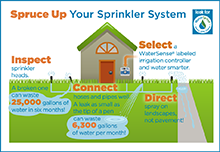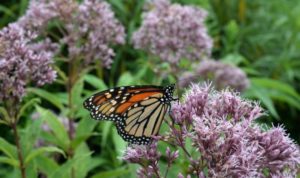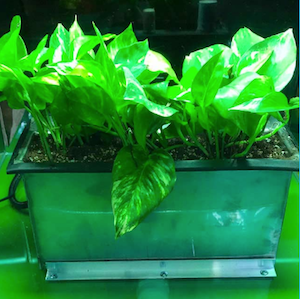
I like a lush green landscape as much as the next person. What I don’t like is a big hefty water bill, especially when I know I can save money by being smarter about how I use water. Experts estimate that 50 percent of the water we use outdoors gets wasted due to evaporation, wind, or runoff from overwatering.
No matter how much or how little water you use, it will save you and money and time to use less water. Here are ten tips that have worked for me that I’m happy to share with you.
Top 10 Tips to Save Water Outside
1. Xeriscape: Plant perennials, annuals, bushes and trees that do not need more water than normally falls in your region. If rainfall is scarce, skip hydrangeas, which require frequent watering to thrive and bloom. You can find a good list of plants and the amount of watering they require here.

3. Plant in “watering zones”: When planting, assign areas of your landscape to different hydrozones depending on sun/shade exposure, soil and plant types, and type of sprinklers you plan to use. Then, adjust your irrigation system or watering schedule based on those zones’ specific needs. With this simple system in place, you’ll avoid overwatering some areas or underwatering others.

5. Water when it makes sense. Know how much water your landscape actually needs before you set your sprinkler. Your local utility or garden center can recommend how much water certain plants need in your region and best times to water. It’s best to water lawns and landscapes in the early morning and late evening because large amounts of water can be lost due to evaporation during the heat of the day.

7. Get some help: Contractors certified through a WaterSense labeled program can audit, install, or maintain home irrigation systems to ensure water isn’t wasted. Make sure you ask for credentials.
8. Use a soil moisture sensor: Grass doesn’t always need water just because it’s hot out. Step on the lawn, and if the grass springs back, it doesn’t need water. An inexpensive soil moisture sensor can also show the amount of moisture at the plant’s roots and discourage overwatering.
9. Cut back on mowing. Longer grass promotes deeper root growth, resulting in a more drought-resistant lawn, reduced evaporation, and fewer weeds. So raise your lawn mower blade to leave the grass longer when you cut it.
10. Give your hose a break: Sweep driveways, sidewalks, and steps rather than hosing them off. And don’t forget to check for leaks at your spigot connection and tighten as necessary.
What Do You Do To Save Water?
We’re always eager to learn from you! If you have some additional ideas to save water outside, please share them below. Thanks!
And here’s another interesting idea for you: some people install water tanks to collect significant amounts of rainfall from their roofs, much more than they’d collect with just a rain barrel. Someone in my neighborhood installed an underground water tank, but there are many other ways to do it. In most parts of Australia, locals make use of rainwater tanks, not only to boost their gardens but for water conservation and sustainability. Water tank suppliers like Rainwater Tanks Direct provide materials as well as help educate citizens about effective rainwater catchment systems.
Related Posts:
Find water-saving timers and devices in our Amazon store here.

















4 thoughts on “Ten Ways to Save Water Outside and Cut Your Water Bill by 50%”
It’s great to learn more on ways how to save water. We can also help more by participating in water saving programs in our communities.
You’re so right! If your community doesn’t have a water-saving program in place, you could work with EPA’s WaterSense folks to start one.
Great tips. Super helpful to saving money. Been using most of them for years, and they help so much its not even funny.
Thanks for the tips it will really help a lot especially to those who are newbie in the world of gardening like me, I will look forward to do every thing you’ve said.
Comments are closed.